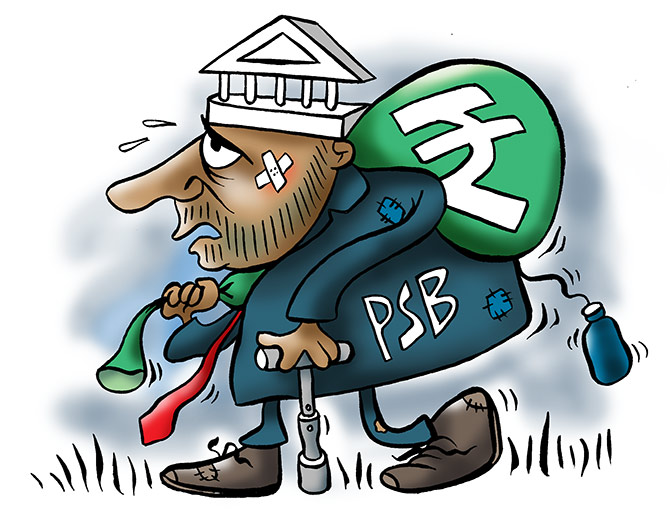'We may bite the bullet and draw up plans for privatisation.'
'If that is done now, the sale of the government stake will fetch money; a delay will see erosion in whatever value is left in these banks,' says Tamal Bandyopadhyay.

Sometime in March 2018, Nandan Nilekani, co-founder and chairman of Infosys Ltd and founding chairman of the Unique Identification Authority of India (Aadhaar), had said the pace at which public sector banks (PSBs) were losing business had increased and that 10 years from now, they would hold 10 per cent market share.
Around the same time, Uday Kotak, executive vice-chairman and managing director of Kotak Mahindra Bank Ltd, had said that private sector banks's market share would go up significantly and equal that of public sector banks in the next five years.
'The 70-30 ratio of public and private banks will move to a 50-50 ratio in the next five years,' Kotak had said.
Nilekani expected the PSB's market share to fall to 63 per cent by 2025.
Pegging the pace at which the public sector banks have been losing their market share at 4 percentage points a year, he had said that in 10 years, this share would be very small and may eventually be reduced to something like 10 per cent.
In private, many public sector bankers at that time had called Nilekani a Cassandra while a few private bankers had dubbed him a soothsayer.
But it seems that Nilekani got it wrong.
The pace at which PSBs have been losing market share is even faster than what he had anticipated.
Let us look at the figures of advances, deposits and total assets in the banking system.
To avoid reference to too many data points, I am clubbing private and foreign banks into one group as the idea is to find out how the market share of government-owned banks is shrinking.
In the 1990s, before the Reserve Bank of India gave licences to the first set of private banks to open shop, the PSBs had 90 per cent share of the banking market.
In 2000, their share was a little over 80 per cent.
By 2014, they held around three-fourths of the market share in deposits, advances and total assets.
There has been a dramatic slide in the past five years.
This set of banks had 75.74 per cent share of advances of the banking industry in 2014.
It dropped to 74.12 per cent in 2015 and by 2019, it was 61 per cent.
This is about stock; if we analyse the incremental advances or the growth in advances every year, the PSBs's share is falling at a sharper pace.
It was 73.45 per cent in 2014 and dropped to 23.75 per cent in 2019.
In sync with this, the government-owned banks's share in the overall assets has been sliding -- from 72.6 per cent in 2014 to 61.22 per cent in 2019.
Here, the fall in the incremental market share will look unreal for someone not familiar with the industry -- from 72.6 per cent in 2014 to 9.51 per cent in 2019.
What about the pie of deposits?
In 2014, PSBs had 77.2 per cent share of the banking industry’s deposit portfolio.
This has been progressively coming down.
In 2019, it was 65.85 per cent.
Despite enjoying an implicit sovereign guarantee, PSBs have not been able to compete with private banks to garner deposits.
In 2014, 76.42 per cent of the incremental deposits flowed into the public sector banking industry; in 2019, it was 20.48 per cent.
The latest RBI publication on trends and progress in Indian banking says private banks have attracted 77 per cent of the incremental term deposits.
The reason attributed to this is higher interest rates offered by them.
This could be one reason. The other, and probably the more plausible, explanation could be that most public sector banks are suffering from an existential crisis in the new banking world, disrupted by technology.
Large private banks such as HDFC Bank Ltd, ICICI Bank Ltd, Axis Bank Ltd are not offering higher interest rates to woo the depositors but, armed with technology, they are offering personalised and structured liability products, scoring over their counterparts in the public sector.
State Bank of India and Bank of Baroda are the possible exceptions among PSBs.
They are changing their ways of customer connect, using technology, but most others are watching the erosion in market share helplessly.
Similar helplessness by State-owned enterprises is seen in the telecom and aviation sectors.
In the life insurance industry, Life Insurance Corporation of India is putting up a brave fight, but private entities are grabbing the incremental market share at a fast pace.
In the past five years, their share in new business premium has been rising at a 20 per cent compounded annual growth rate, double that of LIC.
For the so-called weighted received premium (WRP), the first year's premium and 10 per cent of single premiums, the private life insurers have outperformed LIC in the past four years.
Between 2014 and 2019, their market share in individual WRP has grown from 38 per cent to 58 per cent.
Between 1993 and 2014, India got 14 new banks (not all of them survived).
Since then, two universal banks, 10 small finance banks and a few payments banks have come up.
They have contributed to the fall in the market share of PSBs.
However, the real reason behind the sudden drop in businesses since 2015 has been the Indian banking regulator's massive clean-up drive.
The surge in bad loans is forcing banks to provide more for such loans, leading to losses and they do not have enough capital for a healthy balance sheet growth.
The stock market is aware of this story.
The share of PSBs in the Rs 24.5 trillion market capitalisation of the Indian banking industry is 22.31 per cent.
Three private banks individually have more market capitalisation than the country's largest lender, which is holding on to roughly 20 per cent market share in assets.
One may call this phenomenon privatisation by stealth.
Nilekani had pitched for the privatisation of PSBs before their value is eroded by 'creeping privatisation'.
The options before us are clear: We may keep our eyes closed and allow creeping privatisation or bite the bullet and draw up plans for privatisation.
If that is done now, the sale of the government stake will fetch money; a delay will see erosion in whatever value is left in these banks.
Either way, privatisation is inevitable -- how it is done is of academic interest.
Tamal Bandyopadhyay, a consulting editor with Business Standard, is an author and senior adviser to Jana Small Finance Bank Ltd. His latest book is HDFC Bank 2.0: From Dawn to Digital.











